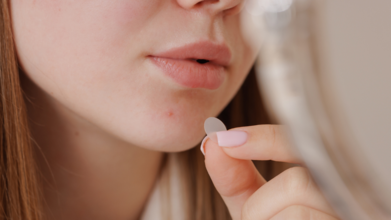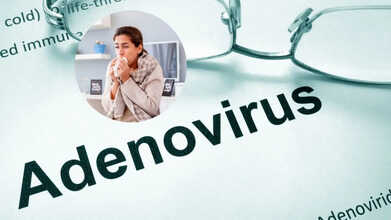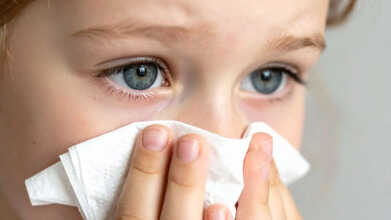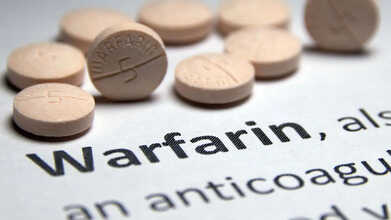- Health Conditions A-Z
- Health & Wellness
- Nutrition
- Fitness
- Health News
- Ayurveda
- Videos
- Medicine A-Z
- Parenting
New Smart Pimple Patch Clears Acne In 7 Days, Ayurvedic Expert Shares Foods That Heal From Within

Credits: iStock
Waking up to a red, big pimple on your face can be an unpleasant shock that ruins your whole day. Now imagine substituting the ordinary routine of squeezing, covering it up, and waiting for weeks until it goes away with the tiny patch that eradicates the blemish in seven days. That's what scientists have done with the latest "smart" pimple patch — and it might revolutionize acne care entirely.
Dermatologists and researchers have been pursuing quicker, more potent treatments for breakouts for decades. Now, a breakthrough might revolutionize the way we approach breakouts.
Researchers have introduced a new microarray acne patch that doesn't only hide pimples—it effectively eliminates them within seven days. Aside from its acne-clearing potential, this intelligent patch also indicates the possibility of a future where technology like this can administer treatments for ailments far beyond the realm of skin care.
How Does The Smart Pimple Patch Work?
Pimple patches, or acne stickers, are not new. The small hydrocolloid-based bandages have been around for years and were intended to pull out excess oil and water from a pimple and protect it from outside bacteria. Some of them contain medications such as salicylic acid or tea tree oil to accelerate healing.
But there are limits to traditional patches. They primarily work on the outer layer of the skin, give only partial solution, and tend to migrate very easily, particularly at night. For individuals with intractable acne, they're more regarded as a "quick fix" rather than a genuine cure. This is where the new patch based on microarray technology differs.
The study, published in ACS Applied Materials & Interfaces, introduced a patch built on a microarray platform—tiny, spike-like structures designed to penetrate the skin’s outer layer and deliver active ingredients directly into pimples.
What distinguishes this patch from others is the design. Rather than smooth spikes that move or irritate skin, researchers employed arrowhead-shaped micro-spikes manufactured using 3D printing. This design enables the patch to "lock on" so that the ingredients in the patch designed to combat acne reach their destination.
The foundation of the patch is composed of hyaluronic acid, a skin care staple for hydration and repair. Within this base, the researchers added two groups of active ingredients:
Day 1 (Antibacterial phase): Salicylic acid and Cannabis sativa extract to destroy bacteria that cause acne and lower oil.
Day 2–7 (Anti-inflammatory phase): Niacinamide and chamomile extract to soothe redness, decrease lesions, and avoid scarring.
The microarray spikes dissolved into the skin in only 30–90 minutes without causing any irritation or residue.
An 81% decrease in acne lesions within three days and total pimple clearance on day seven. Sebum production also fell dramatically, tackling one of the root causes of acne.
Even better news, 95% of the participants were satisfied with the result, experiencing no pain, irritation, or scarring.
"Our research demonstrates the versatility of microarray patches as a platform for uses other than acne therapy, from skin diseases to obesity treatments and vaccine administration," says Kim.
Why Pimple Patches Became Popular?
Anybody who has ever awoken to a red, inflamed pimple can understand the dread it inspires. Old-school pimple patches—the small, sticker-like band-aids—became a quick fix. They usually soak up oil, minimize moisture, and serve as a protective barrier from picking and bacteria. Some have healing or antibacterial properties.
But although these patches facilitate speedy healing, they don't heal fast enough and frequently don't succeed against resistant, inflamed breakouts. The new study hopes to do better by transforming an ordinary acne sticker into a medical delivery system.
How To Naturally Get Acne-Free Skin Without a Pimple Patch?
Acne is more than just a cosmetic issue. Acne strikes approximately 50 million Americans each year, making it the most prevalent skin disorder in the world, states the American Academy of Dermatology. It may cause emotional anguish, poor self-esteem, and in extreme situations, depression.
Skin care innovations are important, but several experts emphasize that acne isn't skin-deep only. Shweta Shah, Celebrity Ayurvedic Nutritionist, tells how ancient wisdom perceives breakouts differently, "Acne in Ayurveda is not just a skin disease but an indicator of imbalance within. It is frequently associated with an overabundance of pitta dosha—the fire element of the body. When pitta grows perturbed, heat and inflammation increase, and toxins set up shop as pimples." Her treatment aims to cool, cleanse, and balance from the inside out.
Juices That Cool the Body
- Coriander + Amla Juice: Cools pitta, promotes skin repair.
- Cucumber + Mint Juice: Hydrates, inflammation-reducing.
- Aloe Vera + Coconut Water: Calms digestion, toxins flush.
Lifestyle Habits for Clear Skin
- Have warm water with trikatu (ginger, black pepper, long pepper) post-meals for digestion.
- Sleep early before 10 PM to permit natural skin repair.
- Steer clear of spicy, oily, fried food. Opt for cooling foods such as steamed vegetables, moong dal khichdi, and fruits such as pomegranate and papaya.
For local treatment, Shah recommends a Neem + Turmeric paste with rose water to address bacteria and inflammation.
Her recommendation points out a glaring fact: despite advancements in technology, healthy skin may start from within balance.
The intelligent acne patch is more than a cosmetic. It is a reflection of an emerging trend toward tailored, non-surgical medical treatments that may be administered through the skin both safely and effectively. For acne victims, it may mean quicker results without the nastier side effects of oral medications.
And if the same technology can deliver therapies for obesity, chronic skin diseases, or even vaccines, then why can't a simple patch could replace pills or injections.
Standard acne treatment tests patience, as changes are not always apparent for weeks or even months. For most people, that wait time spawns anxiety and frustration, perpetuating feelings of shame about appearance. Something that heals in days, however, provides more than a clearer complexion. It provides relief, confidence, and empowerment.
Mental health experts tend to point out that skin conditions such as acne are not merely skin-deep. Being able to observe concrete improvements within a week might help alleviate the emotional impact of acne, contributing to both mental health and self-esteem.
Adenovirus: Is The Mystery Illness That’s Spreading Highly Contagious?

Credits: Canva
A little-known virus is spreading steadily across different parts of the world, prompting growing concern among health experts. Often described as “untreatable” because there is no targeted antiviral medicine available, adenovirus is drawing attention due to how tough it is and how quickly it can pass from person to person.
Eric Sachinwalla, medical director of infection prevention and control at Jefferson Health, has cautioned that while most healthy individuals develop only mild illness, people in high-risk groups may face more serious health problems. This raises an important question: just how contagious is this mystery illness that is spreading?
Adenovirus: How Contagious Is It?
Yes, adenovirus is highly contagious and spreads with ease in several ways. It can pass through respiratory droplets released during coughing or sneezing, close physical contact such as hugging or shaking hands, and contact with contaminated surfaces like toys and towels.
It can also spread through fecal matter, particularly during diaper changes, and in some cases through water. According to the CDC, the virus spreads quickly in crowded settings such as schools and daycare centres and can survive for long periods on surfaces, making good hygiene especially important for young children and people with weakened immune systems.
Who Do Adenoviruses Affect Most?
Adenoviruses can infect people of all age groups, but they are most commonly seen in children under the age of five. In babies and young children, the virus often spreads in daycare environments where close contact is common. Children are also more likely to put shared objects in their mouths and may not wash their hands as regularly.
Among adults, adenoviruses tend to spread in crowded living conditions. People staying in dormitories or military housing may have a higher risk of infection. The virus is also known to circulate in hospitals and nursing homes, as per CDC.
Those with weakened immune systems are more likely to become seriously ill from an adenovirus infection. This includes people who have undergone organ or stem cell transplants, as well as those living with cancer or HIV/AIDS. Individuals with existing heart or lung conditions may also face a higher risk of severe illness.
Adenovirus: What Are The Symptoms Of An Adenovirus Infection?
The symptoms of an adenovirus infection depend on the part of the body affected. Most commonly, the virus targets the respiratory system. When it infects the airways, it can cause symptoms similar to a cold or the flu. These may include:
- Cough.
- Fever.
- Runny nose.
- Sore throat (pharyngitis).
- Pink eye (conjunctivitis).
- Ear infection (otitis media).
- Swollen lymph nodes.
- Chest cold (bronchitis).
- Pneumonia.
Adenoviruses can also infect the digestive system. When this happens, diarrhea may occur, along with gastroenteritis. Gastroenteritis is inflammation of the stomach or intestines and can lead to stomach pain, diarrhea, nausea, and vomiting.
In rarer cases, adenoviruses can affect the bladder or the nervous system. Infection of the bladder may result in urinary tract infections. When the nervous system is involved, it can lead to serious conditions affecting the brain, including encephalitis and meningitis.
Flu Incubation Period: How Long Does It Take For Symptoms To Appear?

Credits: Canva
Influenza, commonly called the flu, is a respiratory infection caused by the influenza virus. It is contagious, which means it passes easily from one person to another. Although influenza viruses can circulate throughout the year, infections are seen more often during the fall and winter months. This time is known as the flu season. As flu cases are rising across many parts of the US and UK, here are a few key points to understand, from the incubation period to how easily the virus spreads.
What Is The Flu (influenza)?
The flu is an infection caused by the influenza virus. It usually leads to symptoms such as body and head aches, sore throat, fever, and breathing-related discomfort, which can sometimes become serious. Flu cases tend to peak during the winter months, when large numbers of people may fall ill at the same time, a situation described as an epidemic, according to the Cleveland Clinic.
Flu: What Is The Incubation Period Of The Flu?
The average incubation period of the flu is around 2 days, though it can vary from 1 to 4 days. In simple terms, this means most people begin to notice flu symptoms a few days after the virus enters the body.
When Does The Flu Become Contagious?
After catching the flu virus, a person can start passing it on to others about 1 dayTrusted Source before symptoms appear. Keep in mind that the usual incubation period is about 2 days. So, if someone is exposed to the virus on a Saturday morning, they may already be able to spread it by Sunday evening. By Monday afternoon, flu symptoms are likely to show up. These symptoms can be mild or severe.
Some people may not develop symptoms at all, but they can still spread the virus. The flu is usually most contagious during the first 3 days of illness. After symptoms begin, a person may continue to infect others for another 5 to 7 days. Children, older adults, and people with weaker immune systems may remain contagious for a longer time.
Flu Symptoms 2025: Early Symptoms You Need To Take Care Of
Unlike the common cold, which tends to develop slowly, flu symptoms often appear suddenly.
Common symptoms include:
- feeling extremely tired, exhausted, or weak
- headache
- blocked or runny nose
- sore throat
- dry cough
- muscle and body aches
- fever or chills, although not everyone gets these
- vomiting or diarrhoea, which is seen more often in children
Most people start to feel better within a few days to two weeks. However, some individuals may need antiviral medication, particularly those at higher risk of serious complications.
How Does The Flu Spread?
The flu mainly spreads through tiny respiratory droplets released when an infected person coughs or sneezes. In crowded places, these particles can be inhaled by others, leading to infection. The virus can also spread by touching objects or surfaces that carry the virus, such as door handles or shared personal items. Outside the body, the virus can survive on surfaces for up to one day.
If someone touches a contaminated surface and then touches their eyes, nose, or mouth, the flu virus can enter the body and cause infection.
Taking Warfarin? Doctor Warns This Common Food Could Be Reducing Your Medication’s Effect

Credits: Canva
People who are prescribed blood thinners, also known as anticoagulants, could unknowingly weaken the effect of their medication by eating a widely consumed and otherwise healthy vegetable, a doctor has warned.
What Are Anticoagulants?
Anticoagulants are routinely given to reduce the risk of blood clots and are often prescribed to those who face a higher chance of such complications. This group also includes people at increased risk of heart attacks or strokes. These medicines, which include rivaroxaban, apixaban and warfarin, work by interrupting the clotting process and play a key role in preventing serious conditions such as strokes, heart attacks, pulmonary embolism and deep vein thrombosis.
Warfarin: Why This Common Vegetable Can Be A Problem
While anticoagulants are effective and often lifesaving, patients are being advised that a familiar garden vegetable could interfere with how well these drugs work. The warning comes from Dr Chris Steele, who appeared on ITV’s This Morning to explain how certain foods can interact negatively with different medications.
As part of his advice, he said, as per Express, “Leafy greens are high in vitamin K, which helps blood to clot. Warfarin works by blocking vitamin K production, so if you suddenly increase how many greens you eat, it can affect how the medicine works.”
He added: “Other foods that contain a lot of vitamin K include green vegetables, egg yolks, chickpeas and lentils. These foods don’t need to be removed from the diet, but it is important to keep your intake steady and consistent. You should also avoid drinking large amounts of cranberry juice or using cranberry products while on anticoagulants, as they can alter the effect of warfarin. Garlic and ginger should be limited too, as they can raise the risk of bleeding.”
Warfarin: Other Food And Drug Interactions To Watch For
Dr Chris also highlighted that many other medicines can react in unexpected ways when taken alongside certain foods and drinks. For example, he noted that some antibiotics, including ciprofloxacin, can react poorly with milk.
He explained: “Calcium can reduce how well some antibiotics work, so these medicines should not be taken at the same time as foods high in calcium, such as milk, yoghurt or cheese. Calcium supplements should also be avoided for a few hours before and after taking these antibiotics.
“You should not drink milk when taking certain antibiotics, including tetracycline and ciprofloxacin, which are quinolone antibiotics, or some osteoporosis drugs like alendronate, also known as Fosamax.”
He further advised avoiding the following combinations with specific medicines:
- Grapefruit if you are taking statins for high blood pressure
- Black liquorice if you are on certain heart medicines such as digoxin
- Bananas if you take some ACE inhibitors for high blood pressure
- Coffee if you use bronchodilators for asthma
- Smoked salmon and salami if you are prescribed antidepressants
- Limes if you are taking cough medicine
Dr Chris stressed: “Always speak to your doctor about any precautions you should follow when starting a new medication. You may need to avoid certain foods, make changes to your lifestyle, or take other steps to prevent unwanted side effects.”
© 2024 Bennett, Coleman & Company Limited

